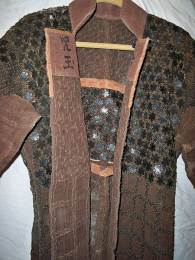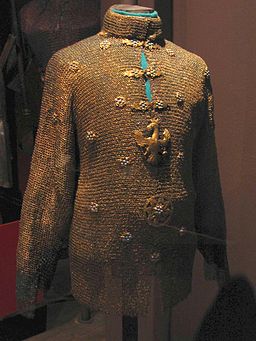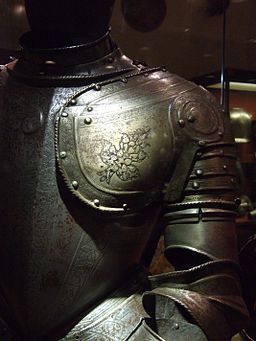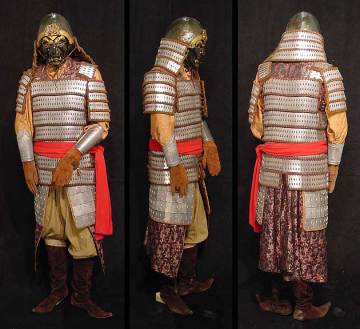 Your character stands on the edge of the battlefield, where the fate of the world will be decided. He prepares to lead the charge that will change history forever. But as he raises his banner high, something is amiss; there’s laughter all around! A sudden gust of icy wind sends a shocking realization to the character—he’s naked.
Your character stands on the edge of the battlefield, where the fate of the world will be decided. He prepares to lead the charge that will change history forever. But as he raises his banner high, something is amiss; there’s laughter all around! A sudden gust of icy wind sends a shocking realization to the character—he’s naked.
Now, obviously your characters aren’t going to jump into the fray with their birthday suits on. That is, of course, unless you intend for them to do so. But chances are, without decent protection, your characters will die. So you’ve got a nude warrior against the world… now what?
Unless streaking is an ancient rite for summoning powerful forces to your character’s aid, you’re going to want to suit them up. But before you choose an armor type for your characters and armies, there are multiple factors that should be considered.
The Last Line of Defense
First and foremost, it needs to be understood that regardless of how much armor and protection—of the non-fantastic sort—is bestowed upon the character, it doesn’t mean that he is invincible. This holds true especially when fireballs and death rays are thrown into the mix.
Armor is the last line of defense in combat. No semi-intelligent warrior is going to willingly allow himself to be struck: he will avoid blows by any means necessary. Your characters should know a thing or two about parrying, blocking, and dodging incoming attacks before heading off to battle—for mobility is critical when it comes to Medieval warfare.
What Lies Beneath
A key fact about armor is that it isn’t just the outer layer that matters. The inner layers can make a considerable difference.

Most armors work best when supplemented by a layer that complements the main defense. Beneath the metal fortress of chainmail or plate armor is a padded suit such as an arming doublet, gambeson, or an aketon. Chainmail works best with pieces of solid armor layered over it to negate bludgeoning force—one of chainmail’s greatest weaknesses.
Weighing Your Options
The heavier and bulkier the armor is, the less mobility the warrior has. Equipment weight plays a role in the warrior’s survivability. Mobility keeps a warrior alive and functional, and the more hindered he is, the more likely he is to be killed.
Furthermore, distribution of that weight is of high importance. Proper weight distribution will ease the burden on the armor-clad warrior and make him a deadlier asset on the battlefield. Even though weight was a serious thing in Medieval combat, it wasn’t so terrible as to make plate-wearing knights immobile and unable to get up after falling to the ground; knights would not go out into a fray just to be knocked over and killed. A knight in a properly fitted and crafted suit of plate could do cartwheels, regardless of the weight of the armor. Moreover, warriors wearing such armors were trained to deal with the weight and encumbrance from a very young age.
Regardless, armor is always a compromise between protection and mobility: a man wearing a suit of plate armor isn’t going to be as nimble as a man wearing leather.
Hide Armor
At the bottom of the food chain is untanned hide armor. Hide armor is the easiest armor to make, considering all it takes is the hunting and skinning of an animal.
But hide armor has many flaws… one being that it stinks horribly. This stench was said to be so pungent that it could give away a group’s location before they were even spotted.
Hide doesn’t last long, either. While it does offer an advantage in mobility, and may be effective against animals, hide is near useless against weaponry; regardless, given the right opportunity, hide will save your characters’… erm… hides. Still, seeing a barbarian warrior clad in wolf pelts with a ferocious bear head for a helmet could be enough to make many a man quail.
Leather Armor
An evolution from hide, leather is far more durable and effective. Leather armor was one of the most widespread and most used types of armor (even up to WWII). Aside from being cheap to make, it also provides significant slashing and bludgeoning defense while offering great mobility. Leather can be hardened, and shaped into various forms during the tanning process. Some hardened leathers can contend with plate and mail.

Leather has its disadvantages as well: leather, like hide, is organic—it doesn’t survive the decay of time; leather also offers limited penetration protection. Even boiled leather won’t reliably stop arrows, hefty battle-axe swings, or sword lunges. Leather is for the more nimble sort of fellow, one who wouldn’t necessarily be in the middle of a melee.
Chainmail
Chainmail, the predecessor to plate and a tough contender to it, lasted from as early as 3rd century BCE well into the Middle Ages, and in some forms is still in use today. Chainmail consists of small, interlocked metallic rings, creating a flexible, durable sheet of protection. While expensive and tedious to craft, chainmail offers superb slashing defense as well as decent piercing protection—enough to stop normal arrows, though perhaps not enough to make charging headlong through a volley appealing. Splinted (or “banded”) mail, a variation, uses chain links to connect small plates in a fashion similar to lamellar armor, combining greater flexibility than tightly-bound plates with greater protection than simple chain.

Mail combines minimal limits on range of motion with a phenomenal amount of protection, as long as it was employed properly. Mail has major issues with weight distribution: much of the weight falls upon the shoulders, though a belt can take up some of the weight. An average suit of mail weighs in at around 40 to 50 pounds, similar to plate armor. Having this weight pressing on your shoulders day in and day out, battle and skirmish and ambush, can be tremendously fatiguing. And if you’re not wearing a gambeson underneath, the chafing can be horrendous.
Chainmail has other weaknesses as well, particularly against bludgeoning force, especially to the joints. While chainmail provides some bludgeoning resistance for the torso due to the need of any such blow to “pick up” the armor draping below the point of impact, a powerful enough swing from any weapon can still break bones. Piercing attacks—specially-designed arrows, crossbow bolts and lances—can break links and penetrate if they are forceful enough.
Plate Armor
Plate armor eventually took over as the champion of Medieval protection, but it has seen action since the time of Ancient Greece and Rome. Aside from the sculptural and artistic possibilities of plate, it is also favored because it transforms whoever wears it into a Medieval tank. The warrior can now charge into battle without the fears he once had with more vulnerable armors; he can now focus on killing his enemies more than ever. Of course, a Medieval warrior had to have quite the purse to buy a suit of plate, for every piece had to be custom built and fitted to the warrior for maximum protection.

A full suit of plate armor covers head to toe, leaving almost no area exposed. Which might make it surprising that it weighs in at only 45-65 pounds. Some plate armor intended exclusively for jousting is heavier, weighing in at as much as 90 pounds, with some pieces several millimeters thick; this armor would never be worn in the field.
Plate was often used in conjunction with chainmail, to protect the weak spots left vulnerable from the absence of the plate. Early combinations saw full chain suit supplemented by pieces of plate over the most vulnerable areas—a combination heavier than full plate; increasingly sophisticated articulation of the plates eventually allowed for the chain to be eliminated altogether.
Plate isn’t invincible—no armor is—and neither were the knights that wore it. Knights still died to arrows and blunt trauma, while weapons such as the halberd were designed specifically to be effective against plate. Anything that could exploit and take advantage of areas left exposed by the joints in the armor was a significant threat. Despite all this, plate armor proved to be a walking fortress on the Medieval battlefield.
Other Varieties
Cloth, as weak as it sounds, does earn some stage time. While it offers limited protection against weaponry, it is better than nothing—with enough layers, much better than nothing. More importantly, padded gambesons are a necessary component beneath nearly all other kinds of armor, especially metal ones.
Several other significant types of armor—all variations on ways to improve the protective value of inexpensive and flexible armor—deserve mention.
The simplest, “splinted” armor, involves riveting metal plates onto another piece of armor; this was largely limited to limb protection. Scale and lamellar armor both follow the same basic notion: numerous small pieces of overlapping leather or metal. The difference? In scale, the pieces are joined at their tops to a backing (usually soft leather) and hang loose at their bottoms, creating a strong yet flexible defense—in fact, scale is the best protection of all against blunt trauma, better even than plate.
In lamellar armor, the plates are fastened to one another, rather than to a backing. Lamellar’s directly-joined plates better retard stabbing: the main weakness of scale armor is that an upward thrust can pass beneath the scales. Later, brigandine—cloth or soft leather garments with small metal plates riveted to the inside of the fabric—emerged to contend in the evolving world of combat.

Price and Availability
Price is yet another major factor to be considered in choosing armor. While chainmail and plate were taking Medieval battlefields by storm, leather still stuck around in the lower ranks due to its affordability. It was prestige and wealth that could accommodate Medieval knights with their treasured plate and chain armors, not the racks in the barracks.
Medieval knights were like Greek Hoplites in the sense that both purchased their own armor, with their own money. Your farmer-boy, rising hero isn’t going to be able to stroll into town, locate a skilled blacksmith, a tailor, and a leatherworker, and buy a suit of plate that fits him without having the coin, and time, to do it.
When in a fantasy setting, you must also take into account the availabilities in resources of your countries and kingdoms. Some countries may need to import the metals like the Mesopotamians once did, due to lack of the required materials in the regions. Smiths capable of creating metal armor, and the availability of the technology or power to craft and create the armors, should also be taken into account. The fewer smiths who can make the armor means there are fewer people who can wear and afford it.
One Key Question
All in all, it boils down to one key question, and that is what type of armor will be appropriate for the situations they will be in. Surely you wouldn’t want to send a knight into the middle of the desert in a suit of full plate armor, or throw a barbarian with only a leather harness and a raggedy loincloth into the heart of a snowy mountain range.
But perhaps some of your characters are flamboyant, and would like to show off that gilded ceremonial plate armor their families prize above all else. Or maybe your proud huntress dons some pieces of her greatest kills upon her leather armor, like a tiger’s pelt for a cape, and a rack of pristine antlers crowning her head.
Whatever the case, armor does have its uses beyond protection; it can reflect characteristics or reveal flaws as well. But, always keep in mind that armor only serves its purpose to an extent, and armor, in all of its varying forms, does not equal invincibility.
So there’s your character, still nude on the battlefront, waiting for you to suit him up to take on the hordes of enemies before him. What armor are you going to give him?


Overall this was a very good, informative article, but I have to point out that leather armour was not all that common. Leather armour is more fantasy than reality, it was far too wasteful. Leather was mainly used for shoes. Gambeson triumphed over leather by far, it was cheaper, readily accessible, and provided better protection. Leather couldn’t protect you from an arrow, gambeson could. I’m not saying that leather armour wasn’t used at all, but you would have been hard pressed to find it on the battlefield.
I was hoping someone somewhere had written an article about this, because I needed some point of reference: just about all my major characters would rather pour vast amounts of time and money into good, well-fitting armor. And wow, thank you for pointing out that little thing about available materials, because I had NOT given that enough consideration.
NOTE: The term “chainmail” was not invented by Gygax and Dungeons and Dragons. It was invented by 19th century scholars who wanted to “clarify” the armor type. Buckley is right, however, that the term is incorrect from the medieval perspective. They just called it mail. They did NOT call plate armor “mail.” So any reference to “platemail” should only mean some kind of combination of mail and plate pieces. I think Gygax DID invent “studded leather” because he did not know what brigandine armor was (from the outside, it looks like leather with rivets all over it).
The RPG industry, in general, has made a complete hash of armor. Pathfinder (an edition I picked up around 2013) has a picture of “chainmail” that has no links visible in it at all. What a joke! The illustrators did not bother to do any research whatsoever before the book was published. They did not even look up the word “chainmail” on a Google image search.
Excellent Post. Your point about layering armor was a good one – hitting something usually neglected by historians, gamers, and authors alike. Layering armor would nullify the disadvantages of any particular type of armor by covering it with a different armor. Plate over mail would provide not just double defense, but specifically would keep mail’s excellent cut defense AND nullify its weakness vs bludgeoning.
Criticism: Your article underestimates cloth armor and leaves the readers thinking that leather would be better. I think if that was the case, more historical documentation would have been found for leather armor. Cloth padding could be layered to enough degree to easily surpass the easily sliced leather. Peasants are shown in quilted cloth all the time. It was not just cheap but effective. The ancient Greeks, of course, perfected the Linothorax, a layered and glued form of cloth armor that replaced their hoplites’ bronze cuirasses for a while.
One quick point that makes me squirm when I hear it. The Term “Chainmail” was invented by Gary Gygax of TSR when he created Dungeons and Dragons. The word “mail” means chain so please use chain armor or mail not the two together. (I used to be an armorer in the SCA.) Otherwise this is a great article for a primer. From the 15th-17th centuries, leather made a great comeback because of its mobility and was less susceptible by lighter thrusting weapons such as rapiers.
Just my $0.02.
Thanks. It really helped me on my Social Studies project!!! XD
There’s one other question about armor, that the end of the post touches on a little: Does the hero want all the armor he can get, or not? Courtiers, spies, and other city types need their swords and things ready to fight, but they can’t do their jobs if everyone looks at them thinking “Wait, why’s he dressed for all-out war?” And a general-purpose “hero” may suspect he’ll be travelling five miles and dodging ten guards of the Evil Army for every one enemy he actually fights, so he’ll stick to leather and such. (Tolkien started the Fellowship’s journey with “The company took little gear of war, for their hope was in stealth and quickness rather than open conflict…”)
Now this is what I’m talking about. It is one thing to do research and travel all over the net, which isn’t necessarily a boring thing to do, but reading a post like this forces context and accuracy, and all in one place. Oh, and it is a fun read. Thanks!
I absolutely love learning about history so when I read a book and I wonder what in the world the author was thinking when they wrote the clothing (or in this case armor) a certain way because it isn’t what it should be I get annoyed. Thanks so much for sharing this great and in depth information.
Very good research and details shared in this post. I’ve copied this into a document and stuck it in my ‘research’ folder. I have yet to write anything where my characters used armor but if I do, I’ll have this as a start to my research.
There is a story I’m reading now where the main character is an assassin and his armor is his weapons. The author does not describe any other type of armor besides clothing revealing house colors, but goes to great lengths describing the weapons and where they are placed. I find it fascinating.
It seems there’s an awful lot of research and planning involved in choosing armor for characters. I had no idea there were so many different types. I can’t imgaine how anyone could move at all wearing some of the heavier kinds.
You did a fantastic job detailing the pros and cons of various armor types! I stick mainly to plate, chainmail, leather, and hide armor in my writing, depending on the character’s class, character, and situation.
Research to ensure you are selecting the appropriate armor for the time period you are attempting to portray is imperative. I’ve always enjoyed chainmail armor, myself.
I appreciate that you’ve put the time into this post. Nothing aggravates me more than to be reading a story and have the author completely mess up on the details. It shows sloppy work and poor research to my mind. I won’t use anything, whether armor or other things, that I don’t know thoroughly. I research extensively as the detail is what makes the story come to life and feel possible.
I love how you’ve gone into detail with the clothing, weapons and other accoutrements of the medieval knight. What a valuable article this is for people writing medieval fantasy.
A useful article you’ve posted here. It’s good to know that quilts were invented to go beneath that heavy, rusty metal garb and that chain mail was once new technology that gave men heads up on the competition.
No, thank you all for reading the article! I hope you enjoyed it as much as I did writing it.
Great post! My current fantasy doesn’t need armour (it’s a different type ;)). But I do have one in the wings that will need lots of armour and details are what make the reader stay grounded in the book- so thanks for those.
And yeah, you don’t want to be so far off about garmets/armour that the reader stops and thinks, “WTF?!”
Thanks for the info!
Excellent advice! A lot of fantasy novels I’ve read don’t really think about the armour that characters wear; they just call it “armour” as a catch all phrase. I think knowing which bit does what can go a long way in your writing. Thanks !
Wow, thanks so much for this! I have bookmarked it as a resource for my writing. And I know what you mean A.M. I often wonder how those heroes in fantasy novels can move so much in their armor, it must be so heavy!
Great post, one many fantasy and historical fiction writers need to read. I hate reading about guys in full plate armor easily jumping around. Thanks for the post.